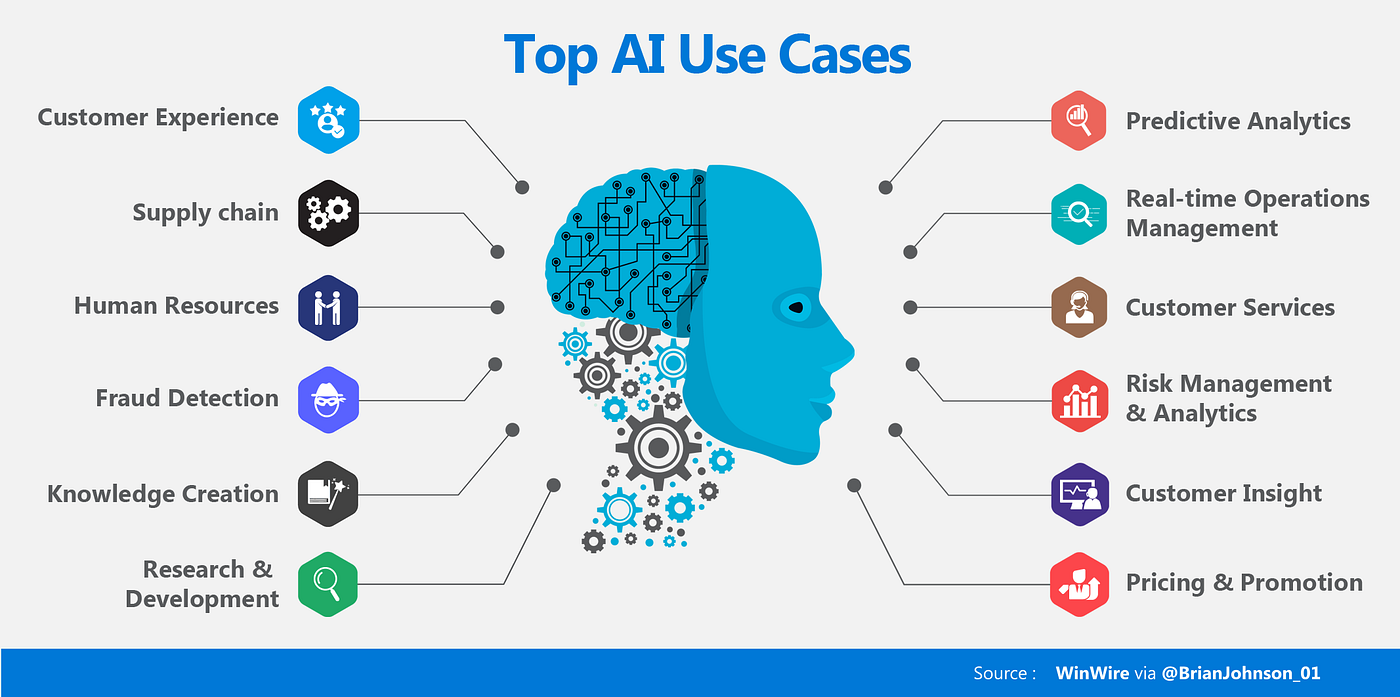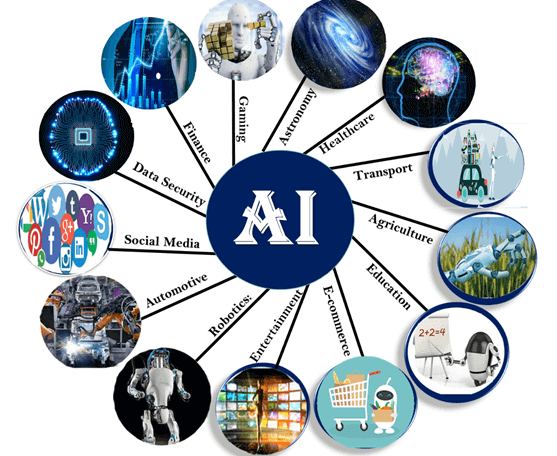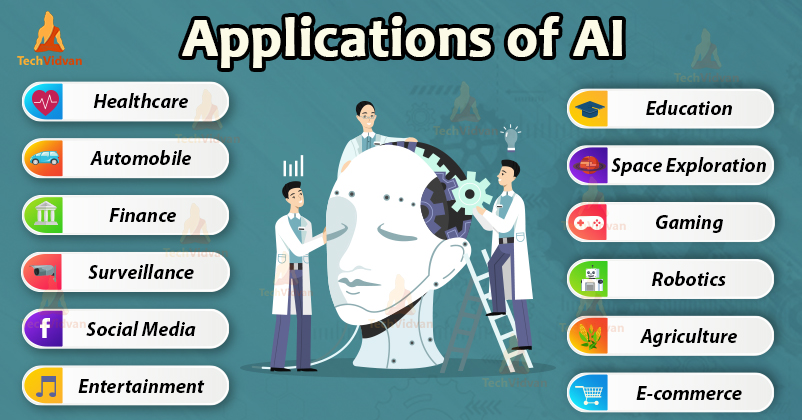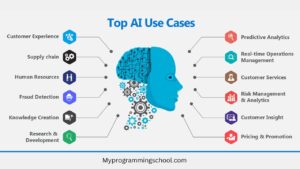AI is used in healthcare, finance, autonomous vehicles, retail, NLP, manufacturing, entertainment, agriculture, energy, education, cybersecurity, space, environment, HR, and legal fields.
In this article, I will explore some of the key areas where AI is utilized, shedding light on the incredible impact it has on our everyday lives. Whether you realize it or not, AI has seamlessly integrated into countless facets of society, and its influence is only set to grow.
Where AI is Used? In some important industries
Healthcare

Diagnosis and treatment
Artificial intelligence (AI) plays a significant role in improving the accuracy and efficiency of diagnosis and treatment in healthcare. With AI-powered systems, medical professionals can analyze large amounts of patient data, such as medical history, test results, and imaging scans, to identify patterns and make accurate diagnoses. AI algorithms can also help doctors develop personalized treatment plans based on individual patient characteristics, leading to more effective and efficient healthcare outcomes.
Drug discovery and development
In the field of pharmaceuticals, AI has revolutionized the process of drug discovery and development. By leveraging machine learning algorithms, researchers can analyze vast amounts of molecular data to identify potential drug candidates. This approach speeds up the discovery process and enables scientists to predict drug efficacy, toxicity, and interactions more accurately. AI also plays a crucial role in optimizing clinical trials by identifying suitable patient populations and predicting trial outcomes.
Patient monitoring and care
AI technologies enable continuous monitoring of patients’ vital signs and other health metrics, both in hospitals and at home. Devices equipped with AI algorithms can detect abnormalities and notify healthcare providers about potential medical emergencies. AI-powered wearable devices can also provide real-time data to healthcare professionals, allowing for remote patient monitoring and more proactive interventions. Overall, AI enhances patient care by providing timely insights and improving health outcomes.
Medical imaging and diagnostics
Medical imaging is a critical component of healthcare diagnostics, and AI has greatly improved the accuracy and efficiency of image analysis. AI algorithms can analyze images from various modalities, such as X-rays, MRIs, and CT scans, to detect anomalies and assist radiologists in making diagnoses. AI-powered diagnostic tools can help identify early signs of diseases, such as cancer, enabling early intervention and improving patient outcomes. Additionally, AI-driven image analysis can reduce the burden on healthcare professionals by automating repetitive tasks and increasing productivity.
Automotive:
Autonomous driving
AI is at the forefront of autonomous driving technologies, enabling vehicles to navigate and operate without human intervention. Self-driving cars rely on AI algorithms, such as deep learning, to analyze sensor data and make real-time decisions based on the environment. These algorithms enable vehicles to detect and respond to obstacles, traffic signs, and other vehicles on the road, ensuring a safe and efficient driving experience. Autonomous driving has the potential to reduce accidents and enhance transportation accessibility for all.
Safety systems
AI technology enhances vehicle safety by providing real-time assistance and alerting drivers to potential dangers. Advanced Driver Assistance Systems (ADAS) use AI-powered sensors and cameras to detect hazards, such as pedestrians or obstacles, and provide warnings or autonomously take control of the vehicle to prevent collisions. These systems help mitigate risks and reduce the severity of accidents, ultimately saving lives and making roads safer for everyone.
Driver assistance
AI-based driver assistance systems complement human drivers by providing assistance in various driving tasks. From adaptive cruise control to lane-keeping assistance, AI algorithms analyze sensor data to support drivers in maintaining safe driving practices. These systems can detect fatigue or distraction and issue alerts to ensure the driver’s attention is focused on the road. Driver assistance technology improves overall driving experience and fosters a safer driving culture.
Vehicle maintenance
AI plays a vital role in vehicle maintenance, helping owners and service providers monitor and identify potential issues before they escalate. Connected cars equipped with AI-enabled systems can collect and analyze data from sensors, detecting abnormalities in engine performance, tire pressure, or other mechanical components. By proactively identifying maintenance needs, AI-powered systems can minimize breakdowns, reduce repair costs, and increase vehicle longevity.
Financial Services:
Risk assessment and management
AI enables financial institutions to better assess and manage risks by leveraging vast amounts of data and advanced analytics. AI algorithms can analyze historical data and market trends to identify patterns and predict potential risks. This technology assists banks, insurance companies, and investment firms in making informed decisions when evaluating creditworthiness, detecting fraudulent activities, or managing investments. By accurately assessing risks, AI systems help safeguard financial stability and protect customers’ interests.
Fraud detection and prevention
In the era of digital transactions, AI has become indispensable in detecting and preventing financial fraud. Machine learning algorithms can analyze large volumes of transaction data, identifying suspicious patterns or anomalies that indicate potential fraud. AI-powered systems can recognize fraudulent activities in real-time, triggering alerts and taking immediate action to prevent further damage. These technologies protect individuals and businesses, providing a secure financial environment for all stakeholders.

Algorithmic trading
AI has greatly transformed the financial industry through algorithmic trading, where computer programs execute trades based on pre-defined rules and market conditions. AI algorithms can analyze vast amounts of financial data, identify trends, and execute trades at high speeds with precision. These automated trading systems can exploit market inefficiencies and make informed investment decisions, resulting in improved returns and reduced human error.
Customer service
AI-powered customer service systems have become common in financial services, providing personalized experiences and timely assistance to customers. Chatbots and virtual assistants equipped with natural language processing capabilities can understand and respond to customer queries, providing round-the-clock support. These AI systems can handle routine inquiries, such as account balance inquiries or transaction history, freeing up human agents to focus on complex customer needs. AI-enhanced customer service improves efficiency and enhances overall customer satisfaction.
Education:
Personalized learning
AI in education enables personalized learning experiences tailored to individual students’ needs and preferences. Adaptive learning platforms leverage AI algorithms to analyze students’ performance data and provide customized learning content. These systems can identify knowledge gaps, recommend relevant materials, and adapt instructional methods to optimize learning outcomes. AI-powered personalized learning ensures that education is more engaging, effective, and accessible to all learners.
Automated grading
AI-supported automated grading systems streamline the evaluation process by automatically grading assignments, quizzes, and tests. By leveraging machine learning and natural language processing, these systems can assess students’ work and provide instant feedback, saving educators valuable time and allowing for faster grading turnaround. Automated grading systems also promote consistency and fairness in evaluations, ensuring that all students are evaluated objectively.
Virtual tutors
AI-powered virtual tutors provide personalized support and guidance to students outside traditional classroom settings. These intelligent tutoring systems analyze student responses and behaviors to identify knowledge gaps and deliver targeted instruction. Virtual tutors can adapt to individual learning styles and preferences, providing tailored explanations, practice exercises, and feedback. This technology enhances learning experiences and enables students to learn at their own pace.

Educational analytics
AI enables educational institutions to harness the power of data to gain insights and make informed decisions. Educational analytics systems can collect and analyze data on student performance, attendance, engagement, and other factors, helping educators identify trends, evaluate teaching strategies, and intervene when necessary. By leveraging AI, educational institutions can optimize resource allocation, improve teaching methodologies, and ensure better student outcomes.
Retail:
Personalized shopping experiences
AI-powered personalized shopping experiences transform the way customers interact with retailers. AI algorithms analyze customer data, such as purchase history, preferences, and browsing behavior, to offer tailored product recommendations and personalized promotions. Virtual shopping assistants can provide real-time assistance, answer customer queries, and guide them through the purchasing process. By personalizing the shopping journey, retailers can enhance customer satisfaction and drive sales.
Inventory management
AI-driven inventory management systems optimize stock levels by analyzing historical sales data, demand patterns, and market trends. These systems can accurately forecast demand, helping retailers avoid overstocking or stockouts. AI algorithms can also automate inventory replenishment processes, reducing manual effort and ensuring that products are available when needed. Efficient inventory management enables retailers to optimize costs, minimize waste, and improve customer satisfaction.
Demand forecasting
Demand forecasting is critical for retail businesses, and AI algorithms excel in predicting customer demand with high accuracy. By analyzing historical sales data, promotional activities, weather patterns, and other factors, AI systems can forecast future demand and enable retailers to make informed decisions regarding production, logistics, and pricing. Accurate demand forecasting optimizes inventory management and helps retailers meet customer expectations while minimizing operational costs.
Chatbots and virtual assistants
AI-powered chatbots and virtual assistants have become commonplace in the retail industry, facilitating customer service and support interactions. These AI systems can understand and respond to customer queries, assist with product recommendations, and provide guidance throughout the purchasing process. AI chatbots can handle multiple customer interactions simultaneously, providing prompt and efficient support at any time. By incorporating chatbot technology, retailers improve customer experiences and free up human agents for more complex inquiries.
Manufacturing:

Quality control
AI technology plays a crucial role in ensuring product quality by automating the inspection and quality control processes. AI-powered systems can analyze product images, sensor data, and historical quality data to detect defects or anomalies. By leveraging machine learning algorithms, manufacturers can identify patterns of quality issues and take preventive actions to maintain consistent product quality. AI-driven quality control enhances productivity, reduces waste, and increases customer satisfaction.
Supply chain optimization
AI algorithms revolutionize supply chain management by optimizing operations and enhancing efficiency. Machine learning models can analyze massive amounts of data, including supplier performance, market conditions, and customer demand, to optimize inventory levels, logistics routes, and production schedules. AI-powered supply chain optimization reduces costs, minimizes delivery lead times, and ensures the availability of products, contributing to overall business success.
Predictive maintenance
AI enables predictive maintenance in manufacturing by analyzing real-time sensor data and machine performance indicators. With machine learning algorithms, manufacturers can detect potential equipment failures before they occur, optimizing maintenance schedules and minimizing unplanned downtime. Predictive maintenance helps save costs associated with reactive maintenance and ensures uninterrupted production, maximizing operational efficiency and productivity.
Robotic process automation
Robotic process automation (RPA) enhances manufacturing operations by automating repetitive tasks through AI-powered robots or software bots. These systems can perform various processes, such as data entry, data validation, and report generation, with minimal human intervention. RPA improves productivity, accuracy, and speed, allowing human employees to focus on more complex and value-added tasks. By leveraging AI, manufacturers optimize resource utilization and reduce operational costs.
Human Resources:
Resume screening and candidate selection
AI streamlines the hiring process by automating resume screening and candidate selection. AI algorithms can analyze resumes, identify relevant skills and qualifications, and match them with job requirements. By eliminating manual screening, AI saves time and effort for human recruiters. Additionally, AI-powered systems can predict candidate success based on historical data and provide insights into the recruitment process, allowing HR professionals to make data-driven decisions.

Employee training and development
AI assists in employee training and development by providing personalized learning experiences and continuous feedback. AI-powered learning platforms can analyze individual employee performance data to identify skill gaps and recommend relevant training materials or courses. Virtual mentors or intelligent tutoring systems equipped with AI can guide employees through their learning journey, enhancing skill development and increasing employee engagement and satisfaction.
Workforce analytics
AI enables HR professionals to harness the power of data to gain insights into their organization’s workforce. Workforce analytics systems can analyze employee data, such as performance metrics, attendance records, and engagement levels, to identify trends and patterns. These insights help HR professionals make data-driven decisions regarding talent management, succession planning, and workforce optimization. AI-driven workforce analytics maximizes employee productivity, improves retention rates, and supports strategic HR planning.
Chat-based HR assistants
AI-powered chat-based HR assistants streamline HR processes by providing instant responses and assistance to employees’ HR-related queries. These AI systems can handle employee inquiries regarding benefits, policies, payroll, and other HR-related topics. Chat-based HR assistants, also known as HR chatbots, can provide 24/7 support, ensuring timely resolution of employee concerns. By automating routine HR interactions, organizations enhance efficiency and improve employee experience.
Entertainment:
Recommendation systems
AI-driven recommendation systems personalize entertainment experiences by analyzing user preferences and providing tailored content recommendations. These systems gather data on user behavior, demographics, and historical choices to predict and suggest movies, music, books, and other forms of entertainment that align with individual tastes. Recommendation systems enhance user satisfaction by increasing the relevance of content offerings and facilitating the discovery of new favorites.
Content creation and curation
AI technology supports content creation and curation in the entertainment industry. Creative AI systems can generate text, images, and even music based on user inputs or predefined styles. These AI-generated outputs can be used in various forms of media, such as articles, advertisements, or music compositions. AI-driven content curation platforms can analyze vast amounts of digital content, filtering and organizing it based on user preferences and interests, ensuring a personalized and engaging entertainment experience.
Virtual reality and augmented reality
AI has transformed the possibilities of virtual reality (VR) and augmented reality (AR) experiences, making them more immersive and interactive. AI algorithms enhance the realism of VR environments and enable real-time interactions, such as object recognition and natural language processing. In AR applications, AI systems can overlay virtual content onto real-world environments, creating interactive and engaging experiences. AI-powered VR and AR push the boundaries of entertainment, allowing users to explore new worlds and engage with captivating digital experiences.
Speech and facial recognition
AI-driven speech and facial recognition technologies enhance entertainment experiences by enabling intuitive interactions. These technologies can analyze spoken words or facial features, allowing users to control devices or characters through voice commands or facial gestures. Speech and facial recognition technology immerses users into entertainment experiences, making them more interactive and intuitive.
Security and Surveillance:
Video analytics and monitoring
AI-powered video analytics and monitoring systems enhance security and surveillance capabilities by analyzing vast amounts of video footage in real-time. These systems can detect suspicious activities, identify objects or individuals of interest, and send alerts to security personnel. AI algorithms can recognize patterns or anomalies in video data, improving the efficiency and effectiveness of security operations. Video analytics and monitoring systems contribute to maintaining public safety and protecting critical assets.
Threat detection and response
AI plays a crucial role in threat detection and response, enabling security professionals to identify potential risks proactively. By analyzing diverse data sources, such as social media feeds, news articles, and sensor data, AI algorithms can identify patterns or indicators of emerging threats. With AI-powered systems, security teams can detect cyber-attacks, physical threats, or other malicious activities and respond swiftly to mitigate risks. AI-driven threat detection and response enhance security measures and safeguard individuals, organizations, and critical infrastructures.
Cybersecurity defense
In the ever-evolving landscape of cybersecurity threats, AI provides powerful defense mechanisms against cyber-attacks. Machine learning algorithms can analyze network traffic, user behavior, and system logs to detect anomalies or intrusions. AI systems can adapt and learn from new attack patterns to constantly stay one step ahead of potential threats. By leveraging AI, organizations can enhance their cybersecurity posture and protect sensitive data, mitigating the risks posed by cybercriminals.
Facial recognition for identification
AI-powered facial recognition technology has revolutionized identification and authentication processes, aiding security and surveillance efforts. These systems can analyze facial features and match them against databases to identify individuals in real-time. Facial recognition technology enhances security protocols by automating access control, enforcement of identity verification, and surveillance operations. It enables efficient and accurate identification, facilitating public safety and protecting sensitive locations.
Transportation and Logistics:
Route optimization
AI algorithms optimize transportation routes based on various factors, such as traffic conditions, weather forecasts, and delivery schedules. These systems can analyze multiple data sources in real-time to calculate the most efficient routes, reducing transportation time and costs. Route optimization ensures timely deliveries, enhances operational efficiency, and minimizes fuel consumption, contributing to sustainable transportation practices.
Fleet management
AI-driven fleet management systems monitor and optimize the performance of a fleet of vehicles. By analyzing data on vehicle location, fuel consumption, maintenance schedules, and driver behavior, these systems can support efficient fleet management practices. AI algorithms can optimize routing, schedule maintenance activities, and monitor driver performance to increase productivity and reduce operational costs. Fleet management solutions powered by AI enhance logistics operations and streamline transportation processes.
Warehouse automation
AI technologies automate warehouse operations, enhancing efficiency and reducing manual labor. AI-powered systems can automate tasks such as inventory management, order fulfillment, and sorting, using robots or intelligent software solutions. By optimizing warehouse layouts, analyzing demand patterns, and streamlining inventory processes, AI-driven automation increases productivity, reduces errors, and improves overall operational efficiency.
Package delivery tracking
AI-enabled package delivery tracking systems enhance supply chain visibility and customer satisfaction. By leveraging AI algorithms, logistics providers can provide real-time tracking information to customers, enabling them to monitor the status and location of their packages. AI-powered tracking systems can analyze vast amounts of data from multiple sources, such as GPS, sensors, and delivery routes, to provide accurate and timely updates. Improved package delivery tracking ensures transparency, reduces delivery delays, and strengthens customer trust.
What are the different types of AI?
Based on a variety of factors, artificial intelligence (AI) can be divided into numerous categories. Based on its resemblance to the human mind and its capacity to “think” and “feel” like humans, AI can be categorised in some ways. There are four categories of AI or AI-based systems, according this classification:
Reactive Machines: The first kind of AI systems, these have very little power. However, they lack memory and the capacity to draw lessons from the past. Instead, they mimic the reactive behaviour of the human mind.
Limited Memory Machines: These devices have the capabilities of reactive machines, but they also have a little amount of memory. To a certain extent, they can draw lessons from the past.
Theory of Mind: This type of AI refers to machines that can understand human emotions, beliefs, intentions, and mental states. They can attribute mental states to others and predict their behavior.
Self-aware AI: This is the most advanced type of AI that possesses consciousness and self-awareness similar to humans. It can understand its own existence, emotions, and thoughts.
Another way to classify AI is based on its capabilities:
Artificial Narrow Intelligence (ANI): ANI is a term for AI that has been specifically created to carry out narrowly focused activities. Voice assistants like Siri and Alexa are two examples.
Artificial General Intelligence (AGI): This is a technology that tries to mimic human intelligence in a variety of jobs. It has similar capacities for learning, thinking, and performance as humans.
Artificial Superintelligence (ASI): ASI refers to AI systems that surpass human intelligence in almost every aspect. It represents an advanced level of intelligence beyond human capabilities.
These classifications provide a framework for understanding the different types of AI and their capabilities. However, it’s important to note that AI research is an evolving field, and new types of AI may emerge in the future as technology advances.
what are the applications of artificial intelligence?
Artificial Intelligence (AI) has a wide range of applications across various industries and fields. Here are some of the key applications of AI:
- Education:
- Personalized learning platforms.
- Automated grading and assessment.
- Intelligent tutoring systems.
- Education data analytics.
- Healthcare:
- Disease diagnosis and prediction.
- Personalized treatment recommendations.
- Drug discovery and development.
- Medical image analysis (e.g., X-rays, MRIs, and CT scans).
- Health monitoring and wearable devices.
- Finance:
- Algorithmic trading and stock market prediction.
- Fraud detection and prevention.
- Credit risk assessment.
- Customer service chatbots.
- Personalized financial advice and wealth management.
- Autonomous Vehicles:
- Self-driving cars and trucks.
- Advanced driver-assistance systems (ADAS).
- Traffic management and optimization.
- Retail:
- Recommendation systems (e.g., Amazon’s product recommendations).
- Inventory management and demand forecasting.
- Automated customer service.
- Visual search and product recognition.
- Natural Language Processing (NLP):
- Language translation.
- Sentiment analysis.
- Chatbots and virtual assistants.
- Text summarization.
- Speech recognition.
- Manufacturing:
- Quality control and defect detection.
- Predictive maintenance.
- Supply chain optimization.
- Robot automation and control.
- Entertainment:
- Content recommendation on streaming platforms.
- Video game AI.
- Music and art generation.
- Interactive storytelling.
- Agriculture:
- Crop monitoring and yield prediction.
- Precision farming.
- Pest and disease detection.
- Agricultural robotics.
- Energy:
- Energy consumption optimization.
- Predictive maintenance for energy infrastructure.
- Grid management and renewable energy integration.
- Cybersecurity:
- Threat detection and prevention.
- Anomaly detection in network traffic.
- User authentication and access control.
- Space Exploration:
- Autonomous spacecraft navigation.
- Data analysis from space telescopes and rovers.
- Mission planning and scheduling.
- Environmental Conservation:
- Wildlife monitoring and poaching detection.
- Climate modeling and prediction.
- Pollution tracking and management.
- Human Resources:
- Resume screening and candidate matching.
- Employee performance analysis.
- Employee engagement and retention.
- Legal:
- Document review and contract analysis.
- Legal research assistance.
- Predictive legal analytics.
These are just some examples of AI applications, and the field continues to evolve rapidly, with new applications emerging regularly. AI has the potential to enhance efficiency, decision-making, and innovation across a wide range of domains.
Conclusion: Where Ai Is Used
In conclusion, AI has made significant advancements in various industries, transforming the way we diagnose and treat diseases, drive vehicles, manage finances, educate learners, run businesses, manufacture products, manage human resources, entertain audiences, ensure security, and streamline transportation and logistics. With continued research and development, AI will further revolutionize these industries, opening up new possibilities and improving the quality of life for individuals and societies worldwide.
Related Articles:
